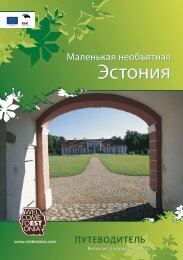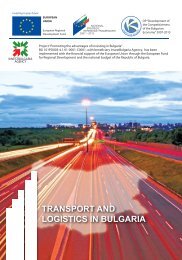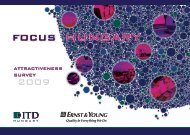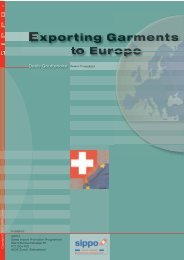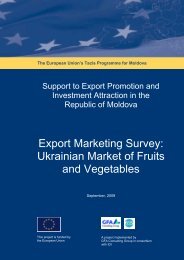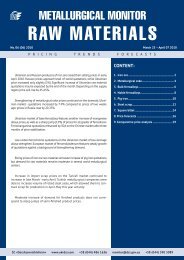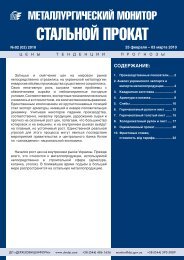Untitled
Untitled
Untitled
Create successful ePaper yourself
Turn your PDF publications into a flip-book with our unique Google optimized e-Paper software.
| Tourism in Hungary: A natural choice for investors | | 2010. |<br />
| 2010. | | Tourism in Hungary: A natural choice for investors |<br />
Dear Investor,<br />
Tourism is one of the fastest growing sectors in the world economy, and it is an<br />
industry that promotes global peace and understanding.<br />
With this in mind, the government’s New Hungary development programme<br />
has ranked tourism as a priority industry to drive future growth. Within the industry<br />
itself, we have defined a clear methodology, known as the National Tourism<br />
Development Strategy, to guide all stakeholders towards this common goal.<br />
Without attempting to cover every detail, we have produced this brochure to<br />
introduce just some of the opportunities open to investors and outline the state<br />
and EU incentives available to promote long-term development.<br />
The economic crisis has affected everyone, and obviously the tourism industry<br />
could not remain unscathed either. But even through these diffi cult times, we<br />
cannot lose sight of our strategic goals. Because recession - no matter how long<br />
and painful it turns out to be - would not last forever. It gives hope for the future<br />
that our industry has always adapted well to new challenges, and it has been<br />
able to reinvent itself drawing strength from adversity.<br />
I am confi dent investors choosing Hungary will help us develop the innovative<br />
ideas and products that will make our country more attractive to tourists from<br />
around the world than ever. We hope to capture your imagination and look forward<br />
to a bright future together.<br />
Dr. Miklós Kovács<br />
State Secretary for Tourism<br />
Ministry of Local Government<br />
When CP Holdings invested into the Danubius Hotels<br />
Group, it was attracted to Hungary because of its impressive<br />
architecture, its healing natural thermal waters and<br />
mud, its good food and wine, its reputation for hospitality<br />
and its well educated people. With a fi ne site on the<br />
Danube, Budapest is a diamond in the heart of Europe<br />
and Hungarian spas are amongst the best in the world. In<br />
fact, Hungary has all the right ingredients for a successful<br />
hotel business, including MICE business, health spa,<br />
leisure and recreational tourism.<br />
John Smith, Director, CP Holdings Ltd<br />
and Vice Chairman, Danubius Hotels Group<br />
The top 15 nationalities visiting Hungary in 2008<br />
Rank Country Visitors Guest nights<br />
1. Germany 562,057 2,348,304<br />
2. Austria 244,824 687,750<br />
3. UK 255,276 623,114<br />
4. USA 184,219 478,317<br />
5. Italy 171,203 443,011<br />
6. Romania 243,376 427,505<br />
7. Poland 154,627 419,090<br />
8. Spain 141,547 353,543<br />
9. Holland 92,123 349,882<br />
10. France 135,792 331,868<br />
11. Russia 88,529 311,565<br />
12. Czech Rep. 108,767 302,906<br />
13. Denmark 43,934 208,072<br />
14. Sweden 61,813 179,978<br />
15. Japan 72,710 162,867<br />
Source: HNTO 2009<br />
Why invest in the Hungarian<br />
tourism industry?<br />
• Steady increase in foreign visitor arrivals. Neighbouring countries are also<br />
potential senders due to their economic improvement.<br />
• Hungary’s relevance as a tourist destination will increase due to its favourable<br />
geographical features, its security and easy road access.<br />
• Unique geothermal characteristics of Hungary contribute to the growth of<br />
wellness and health tourism. Long traditions and know-how in the usage of<br />
thermal water also attracts foreign tourists.<br />
• Great potential in conference tourism in the regional capitals. Budapest has<br />
already grown into a popular MICE destination.<br />
• Growing occupancy rate in the 4* and above category accommodation.<br />
• Six cultural and two natural locations in Hungary have been assigned World<br />
Heritage status. These include the wine region of Tokaj, the city centres of<br />
Budapest and Pécs, the Abbey of Pannonhalma, the traditional village of Hollókô,<br />
the national park in Hortobágy, the Fertô lake landscape and the stalactite<br />
caves of Aggtelek. In addition Hungary’s natural treasures are well protected:<br />
10% of the territory of Hungary is under environmental protection.<br />
• There is still a relative lack of quality accommodation (especially in the countryside)<br />
due to under-development of the sector and a lack of financial capital.<br />
Dear Partners,<br />
• Investment projects are available in the fi eld of theme parks, thermal, golf and<br />
casino tourism, and castle renovation.<br />
Hungary is not only one of the region’s most attractive tourist destinations, but<br />
also a bustling business hub in the very heart of Europe. Located along Europe’s<br />
main crossroads, the country is the perfect place for investors seeking<br />
to expand their operations in Central and Eastern Europe. In Hungary, your<br />
company will also fi nd a highly skilled, creative, motivated, fl exible and hardworking<br />
workforce.<br />
Hungary is a land of creativity, with information and communications<br />
technology undoubtedly one of the main drivers of innovation and economic<br />
growth. Scores of multinational companies have based their manufacturing<br />
and service operations and, in some cases, European headquarters and R&D<br />
centres in Hungary, bringing in some EUR 70 billion in foreign direct investment<br />
over the years.<br />
ITD Hungary, the government’s investment and trade development agency,<br />
is committed to promoting Hungary as a prime investment location and a reliable<br />
business partner. This is why we have embarked on co-publishing this<br />
brochure to introduce the Hungarian tourism industry, the many investment<br />
opportunities this sector offers and the main stimulants the government deploys<br />
in order to be even better positioned in the global race for foreign direct<br />
investments.<br />
An advantageous geographical location, a safe legal environment, an advanced<br />
business infrastructure and a committed labour force are the main ingredients<br />
in the “Hungarian Mix” – an effective stimulant of long-term progress<br />
and prosperity, even during these challenging times of global recession.<br />
Hungary and Budapest was an obvious choice when Interstate<br />
Real Estate Developer PLC., the investor of the<br />
Ramada Resort – Aquaworld Budapest complex project<br />
decided to build one of the biggest indoor water theme<br />
parks in Europe.<br />
The country is literally fl oating on a sea of medicinal water.<br />
Since Roman times, the area has been scattered with<br />
baths and the healing power of thermal springs has been<br />
known for centuries. This exceptional gift of nature coupled<br />
with an excellent location, advanced infrastructure<br />
and lively business climate has encouraged our company<br />
to build the centre, a giant dome, fi ve storeys high and<br />
with a diameter of 72 m along the M0 Budapest ringroad,<br />
in a green area, yet close to the town centre. Through<br />
the project, our company assumes a signifi cant part in<br />
the development of the wellness market, a prospective<br />
world-leading industry, and it contributes to boosting the<br />
tourist appeal and competitiveness of Budapest.<br />
World heritage site: Pannonhalma Abbey<br />
World heritage site: Hortobágy National Park<br />
• Competitive wages: less than half of the Western European average according<br />
to Eurostat.<br />
• A National Tourism Strategy has been developed. Government bodies and<br />
ITD Hungary provide effective support for tourism investments.<br />
Spending of foreign tourists in Hungary (million HUF)<br />
750000<br />
700000<br />
650000<br />
600000<br />
550000<br />
500000<br />
597366<br />
635996<br />
677741<br />
639308<br />
2004 2005 2006 2007 2008<br />
730778<br />
Source: Central Statistical Offi ce<br />
Csaba Kilián<br />
CEO / Executive Investment Director<br />
Katalin Pfandler, President<br />
Aquaworld Hotel and Water Theme Park PLC.<br />
World heritage site: Tokaj wine region<br />
2<br />
3
| Tourism in Hungary: A natural choice for investors | | 2010. | | 2010. | | Tourism in Hungary: A natural choice for investors |<br />
The importance of Hungarian<br />
tourism for the national economy<br />
Tourism has developed into a global driver of economic development in recent<br />
years and the European Union remains the world’s most popular destination.<br />
The attractiveness of Eastern Europe has also grown significantly. There are large<br />
numbers of sites in Hungary of great interest to European and global tourists.<br />
Hungarian tourism in figures<br />
Inbound tourism<br />
In 2008, 12.7 million foreign tourists arrived in Hungary,<br />
an increase of 4.6% on the previous year. (Visitors from<br />
neighbouring countries crossing borders just to do some<br />
shopping, fill up their tanks or dental cavities are not<br />
counted.) The overall spending of foreign tourists amounted<br />
to 730.8 billion HUF, a 14.3% increase over 2007.<br />
Breakdown of arrivals by tourist regions<br />
Western Transdanubia<br />
A = 11.8%; +12.8%<br />
N = 11.6%; +9.3%<br />
Central Transdanubia<br />
A = 4.2%; -4.8%<br />
N = 3.8%; -17.4%<br />
Lake Balaton<br />
A = 16.8%; 0.0%<br />
N = 22.7%; -1.8%<br />
Budapest and the Central<br />
Danube Region<br />
A = 38.4%; +1.0%<br />
N = 34.0%; -3.0%<br />
Northern Hungary<br />
A = 8.2%; -1.1%<br />
N = 7.1%; -1.7%<br />
Northern Great Plain<br />
A = 8.1%; +0.4%<br />
N = 9.1%; -4.4%<br />
Lake Tisza<br />
A = 1.4%; +19.2%<br />
N = 1.5%; +13.6%<br />
Hotel capacity and occupancy<br />
In mid 2008, there were 297,000 beds available at 2,857<br />
hotels and other paid accommodation in Hungary.<br />
Growth in guest numbers at hotels, has been accompanied<br />
by a steady increase in hotel capacity: Over the past<br />
ten years, total hotel capacity has grown by 25.4%. The<br />
number of higher quality rooms has grown fastest, with<br />
four-star hotel capacity increasing by 133.9%, and fivestar<br />
rooms by 161.1% since 1998. At the same time, one-<br />
The signifi cance of the tourism sector is supported by offi cial fi gures showing<br />
the industry accounting for 8.5% of Hungary’s total GDP with multiplier effects<br />
factored in. Almost 400,000 people are employed in the sector.<br />
Fifty percent of commercial accommodations was occupied<br />
by foreign visitors.<br />
Compared to 2007, the number of foreign visitors grew by<br />
1.1% in 2008, while the number of foreign guest nights<br />
Southern Transdanubia<br />
A = 4.8%; -3.7%<br />
N = 4.4%; -1.0%<br />
A = Arrivals, N = Guest Nights<br />
Southern Great Plain<br />
A = 6.3%; +0.6%<br />
N = 5.8%; +2.2%<br />
Source: HCSO preliminary data<br />
and two-star hotels have fallen in number. It is worth noting<br />
that despite the increase in capacity, occupancy has grown<br />
from 47.5% in 1998 to 48.1% in 2008.<br />
In addition to commercial hotels, private accommodation<br />
The economic and social role of tourism is equally signifi cant, with investment in<br />
the sector leading to rapid growth in standards of living for locals and the quality<br />
of services offered to visitors. The promotion of science and culture would<br />
also be unthinkable without strategic development of the tourist industry.<br />
decreased by 2.3% with 3.5 million foreign visitors spending<br />
a total of 9.9 million guest nights in paid accommodation.<br />
Foreign guests spent eight out of ten nights in paid<br />
accommodation.<br />
After 2007, a record year for Hungarian commercial<br />
25<br />
20<br />
15<br />
Guest nights in paid accommodations (million nights)<br />
– village tourism and B&B accommodations have grown<br />
in importance: some 39,000 private guest houses offer<br />
223,000 beds to visitors.<br />
A fall in private accommodation year-on-year has been accompanied<br />
by a growth in guest numbers, resulting in a<br />
Against this background, development of tourism is one of Hungary’s strategic<br />
linchpins. The main goal of this strategy is the long-term and sustainable<br />
improvement of living standards through the economic, social and environmental<br />
factors related to tourism. This strategy will be built on the following<br />
fi ve pillars.<br />
accomodations, figures for 2008 have remained more or<br />
less unchanged: 7.6 million guests (a slight increase of<br />
1.5% over 2007) spending 19.8 million guest nights (a<br />
drop of 1.5% over 2007) in hotels and other commercial<br />
accommodations. In line with international trends, the<br />
average stay shortened to 2.6 nights per visitor.<br />
10<br />
5<br />
0<br />
2001 2002 2003 2004 2005 2006 2007 2008<br />
Foreign visitor arrivals (millions)<br />
growth in occupancy rates.<br />
1. Competitive, sustainable development<br />
2. Product and destination development<br />
3. Development of general and tourist infrastructure<br />
4. Development of human resources<br />
5. Institutional structures<br />
The country is blessed with a remarkable range of tourism products, making it<br />
an important destination for health, historical and conference tourism. Domestic<br />
tourism development represents a further opportunity to develop golf and<br />
hunting tourism, castles and theme parks.<br />
There is already a large number of foreign companies present in Hungary,<br />
which tends to inspire confi dence in new investors.<br />
The importance of health is increasingly noticeable all over the world, a phenomenon<br />
that is no longer a possibility for Hungary but a fully developed industry,<br />
thanks to the country’s highly developed network of thermal and wellness<br />
spas. The thermal and medicinal springs all over the country and the related<br />
services offered already play a key role in health tourism. Around 80% of the<br />
country’s surface has access to thermal water and favourable geothermal characteristics<br />
to rival Japan, Iceland, Italy and France.<br />
The majority of hotel guests arrived from various European<br />
countries with citizens of EU member states accounting<br />
for 75% of guests nights in 2008. Growth of guest nights<br />
in three-, four- and five-star hotels was highest, while one<br />
and two-star accommodation saw a fall in business. In addition<br />
to a consolidation of hotel capacity, the popularity<br />
of premium services also experienced steady growth.<br />
42<br />
41<br />
40<br />
39<br />
38<br />
37<br />
36<br />
35<br />
34<br />
30<br />
700000<br />
600000<br />
500000<br />
400000<br />
300000<br />
200000<br />
100000<br />
0<br />
f: forecast<br />
2005 2006 2007 2008f 2009f 2010f 2011f 2012f<br />
Breakdown of guest nights in hotels<br />
1998<br />
2008<br />
5* 4* 3* 2* 1*<br />
The Budapest Hilton on the Castle Hill<br />
Private accommodation<br />
Growth in the number of visitors to private accommodation<br />
was also promising in 2007: 913,000 guests spent more<br />
than 3.7 million nights, the best figures of recent years.<br />
Both paying guests and village tourism showed an increase<br />
in visitor numbers for domestic and international tourists,<br />
with the number of Hungarian guest nights growing 33.1%<br />
and foreign guest nights increasing by 2.3%.<br />
The strategy is based on promoting cultural and historical values and emphasising<br />
their collective national importance. Historical tourism includes cultural<br />
and world heritage sites, as well as protecting natural values and national parks,<br />
equestrian and village tourism, gastronomy and wine tourism, and special festivals<br />
and events.<br />
Based on statistics published by the highly respected International Congress<br />
& Convention Association (ICCA) in 2008, Budapest ranks sixth among the<br />
world’s top conference destinations.<br />
Domestic tourism<br />
The number of domestic guests at paid accommodation<br />
grew by 2.0%, while the number of domestic guest nights<br />
dropped by 0.77% in 2008, totals of 4.1 million and 9.9<br />
million respectively. Intense marketing and promotion<br />
campaigns lead to half of total guest nights being spent by<br />
domestic customers. The average length of domestic stays<br />
11%<br />
8%<br />
Breakdown of guest nights by form of<br />
accommodation (in percentage of total)<br />
1998<br />
2008<br />
5%<br />
13%<br />
63%<br />
10%<br />
6%<br />
4%<br />
8%<br />
72%<br />
The development of strategic destinations is a top priority both in areas yet to<br />
maximise their potential and those that draw the largest numbers of tourists.<br />
was 2.4 days.<br />
Sixty-three percent of domestic guest nights were taken<br />
at hotels.<br />
All data by courtesy of the Central Statistical Offi ce www.ksh.hu<br />
„Gerebi” Riding Lodge at Lajosmizse<br />
4 5
| Tourism in Hungary: A natural choice for investors | | 2010. | | 2010. | | Tourism in Hungary: A natural choice for investors |<br />
European Union funding<br />
for Hungarian tourism<br />
Accession to the European Union and the resulting EU funding has presented<br />
new opportunities for the country and for Hungarian tourism especially.<br />
In the period from 2004 to 2006, the first National Development Plan distributed<br />
HUF 31 billion (EUR 116 million) in European Union funding to the sector.<br />
Between 2007 and 2013 the New Hungary Development Plan will support<br />
tourism development by ten times that amount, HUF 300 billion (EUR 1.1 billion).<br />
In addition to private financing and enabling investments for development projects,<br />
this represents total investment of HUF 500-600 billion (EUR 1.9-2.2 billion).<br />
There are very many untapped possibilities in Hungary and competitiveness can<br />
be increased according to world market trends and demands. The wide variety<br />
of thermal waters, rich cultural heritage, national parks, culinary traditions and<br />
centuries of viticulture are all waiting for investors. The new Hungary Development<br />
Plan is focused on promoting these areas, while tourist development projects are<br />
primarily managed by individual Regional Operative Programmes.<br />
The key goal is to increase the attractiveness of the region for tourists and to<br />
develop related infrastructure and tourism products, services and accommodation<br />
in line with the demands of visitors.<br />
The development of attractions will emphasise those values typically attractive<br />
to visitors and the creation of sophisticated product packages. European Union<br />
co-fi nancing will assist development of thermal and medicinal baths, renovation<br />
of castles and palaces for tourist purposes, high-quality services in conjunction<br />
with museums and heritage sites, environmental protection visitor centres,<br />
and theme and adventure parks. There is also potential for the development of<br />
event infrastructure, sport and conference facilities, as well as construction of<br />
golf courses and renovation of narrow-gauge railways.<br />
New hotels offering high-quality services are also required to increase tourist<br />
capacity alongside the renovation of existing hotels and updating of their<br />
services. In addition to hotel accommodation, business developments such as<br />
conference and incentive facilities must also be promoted.<br />
Some of the funds available for tourism initiatives will be issued in the form of<br />
tenders, while those public investments of strategical importance will receive<br />
support in the form of priority projects. From 2009, expressly profi t-oriented,<br />
privately funded tourism investments will also benefi t from support.<br />
In assessing applications, the goals of the National Tourism Development<br />
Strategy, the nature of the project, the expected number of visitors and guest<br />
nights, the number of jobs created and fi nancial viability are all key factors.<br />
In the period 2007-2008, a total of 247 projects benefi ted from more than<br />
HUF 67 billion (EUR 251 million) in funding to develop tourist attractions and<br />
accommodation. The resulting investments were worth more than HUF 175<br />
billion (EUR 657.6 million), while priority tourism projects received a further<br />
HUF 42 billion (EUR 157 million), resulting in total investment of HUF 63 billion<br />
(EUR 236.7 million).<br />
In 2009-2010, HUF 72 billion (EUR 270.5 million) will be made available to<br />
promote tourism via tender processes, while HUF 30 billion (EUR 116 million)<br />
of EU money will be available for priority tourism projects.<br />
Examples of EU funding<br />
• HUF 1.67bn contract to renovate the park of the Grassalkovich<br />
Palace in Gödöllô, near Budapest, and convert<br />
one of the building’s wings into a museum. EU funding<br />
will finance 90pc of project costs. The palace’s 5,200-<br />
square-metre English garden will also be restored to its<br />
original form. Later, a HUF 1.5bn-1.6bn four-star hotel<br />
is to be built at the palace with the involvement of a<br />
private investor.<br />
The inner court of the Grassalkovich Palace<br />
in Gödöllô<br />
• Hunguest Hotels will complete a spa complex in Szeged<br />
by the end of 2009. The company is paying for the complex<br />
with HUF 3bn in EU funding, a HUF 3bn loan from<br />
the Hungarian Development Bank (MFB) and HUF 1bn<br />
from a capital raise and inter-group loans. Another HUF<br />
1bn will come in the form of an in-kind contribution of<br />
property by the Szeged local council.<br />
Hotel Palota with Lake Hámori in Lillafüred<br />
• Hunguest Hotels is undertaking HUF 900m in developments<br />
at three of its hotels in northeast Hungary. The<br />
company has signed a contract for HUF 350m in state<br />
and EU development funding for the projects. Hunguest<br />
Hotels will renovate the three-star Hotel Flora’s wellness<br />
centre in Eger, set up a 300-seat conference room in the<br />
four-star Grandhotel in Galyateto and convert the threestar<br />
Hotel Palota in Lilafured into a four-star hotel. The<br />
developments are expected to boost guest nights at the<br />
three hotels by 20pc within five years.<br />
• In April, Hoffmann Hotel laid the cornerstone for a HUF<br />
1.8bn expansion of its Hotel Ozon, in Matrahaza (NE<br />
Hungary), at the same time a contract for HUF 600m in<br />
state and EU support for the project was signed. Hoffmann<br />
Hotel will add 33 rooms and suites to the hotel,<br />
which currently has 46 rooms. A 220-seat conference<br />
centre and a wellness centre will be completed by the<br />
winter holidays, he added. Another new element will be a<br />
pub with a capacity for 120 guests.<br />
Maximum regional intensity rates of state subsidies<br />
Incentives<br />
The Hungarian Investment and Trade Development Agency (ITD Hungary)<br />
supports high-value investments aiming to establish new tourist facilities<br />
with a one-stop shop service. As part of the support package, ITD Hungary<br />
undertakes all-inclusive project management for projects granted direct cash<br />
subsidies (EKD), and provides VIP treatment and comprehensive information<br />
about other subsidies available for high-value investment projects.<br />
I. The Hungarian Government offers a special incentive package for projects<br />
with eligible costs exceeding EUR 50 million. The Package may consist of the<br />
following elements:<br />
1. Direct subsidy assessed by individual Government decision (EKD)<br />
• Non-refundable subsidy, defi ned as a percentage of eligible costs, based<br />
on the Government’s decision<br />
• At least 100 (or, in preferred regions, 50) new jobs must be created<br />
• On receipt of all necessary project data, ITD Hungary will send an offi cial<br />
incentive offer within 30 days<br />
2. Development tax allowance<br />
• Minimum HUF 3 billion (approx. EUR 11.1 million) investment with<br />
150 new jobs in developed regions and HUF 1 billion (approx. EUR 3.7<br />
million) with 75 new jobs in less developed regions<br />
• 80% of corporate income tax (currently 19 %) can be deducted for a<br />
period of up to 10 years<br />
3. Training subsidy<br />
• From 25% to 90% of total training costs, depending on the type of<br />
training, the size of the applicant and the location of the investment<br />
• Available for investments creating at least 50 new jobs<br />
4. Job creation subsidy<br />
• Issued to projects for which cash subsidy based on individual Government<br />
decision is granted; in preferred or most preferred locations, and which<br />
create at least 500 jobs, or at least 200 in most preferred locations). The<br />
ratio of registered unemployed within the newly-recruited staff exceeds<br />
50% and 30%, respectively.<br />
• Subsidy per investment:<br />
– HUF 260 million (EUR 0.9 thousand) if headcount increases by at least by 500<br />
– HUF 160 million (EUR 0.5 thousand) if headcount increases by at least by 300<br />
– HUF 80 million (EUR 0.3 thousand) if headcount increases by at least by 200<br />
II. Support schemes for investments below EUR 50 million through tenders cofi<br />
nanced by the European Union. Three forms of schemes are available:<br />
1. EU co-fi nanced cash grant (through ROP tenders)<br />
• This is a non-refundable cash subsidy issued by the National Development<br />
Agency and approved by the EU. ITD Hungary provides full information<br />
on currently open tenders on request.<br />
The other two forms, i.e. Development tax allowance and the Job creation<br />
subsidy are offered under similar conditions as in the package outlined in<br />
section I. In this scheme the amount of the non-refundable cash subsidy for<br />
job creation ranges between HUF 0.8-1.5M (EUR 3000-5000) per new job,<br />
depending on the location and the ratio of disadvantaged employees.<br />
6<br />
7
| Tourism in Hungary: A natural choice for investors | | 2010. | | 2010. | | Tourism in Hungary: A natural choice for investors |<br />
Priority Sectors:<br />
Projects and Opportunities<br />
HEALTH TOURISM<br />
Hungary is extremely rich in thermal waters and its thermal water reserve is<br />
signifi cant even on a world scale, rivalling that of Japan, Iceland, Italy and<br />
France. Thermal water can be found under some 80 % of Hungary’s surface<br />
and in most cases it is rich in minerals and with strong curative power. The<br />
thermal water reserve is huge but not inexhaustable so its utilisation needs<br />
extreme care and the protection of existing resources.<br />
Major investments<br />
in recent years:<br />
Spain’s Iberalta Group has signed contracts to make<br />
three tourism investments in Hungary. The group will<br />
build tourist complexes at Tiszakécske and Szolnok (both<br />
C Hungary) with a conference centre and entertainment<br />
facilities. Iberalta will seek international hotel chains to<br />
operate the hotels.<br />
GOLF TOURISM<br />
Although still regarded as the sport of the elite, golf is becoming more and more<br />
popular in Central and Eastern Europe. There are currently seven 18-hole golf<br />
courses and five 9- or 6-hole courses operating in Hungary, mainly in the western<br />
part of the country, and some other developments are also in planning phase.<br />
Profitability, compared to other European destinations is still not very high, but<br />
experience shows that a golf course is often the draw card to attract demand<br />
to other more profitable development components including hotels, conference<br />
facilities, spa and wellness centres, casinos, etc. Additionally, the building of new<br />
golf courses may offer a good opportunity for the regeneration of environmentally<br />
damaged areas and landscaping. Hungary’s abundance of water resources may<br />
be an advantage when it comes to reducing operating costs.<br />
Of the country’s 150 hot water spa baths, there are 36 special medicinal<br />
baths in which the water contains radioactivity, sulphurous acid, salt bromine<br />
carbonate or iodine. Europe’s only cave-spa is in Northeast Hungary, in Tapolca,<br />
while Hévíz lake near lake Balaton is the best known thermal (33 C°)<br />
medicinal lake in Europe. For decades, Budapest enjoyed the moniker “the<br />
world’s spa capital” and some of its baths were already in operation during<br />
Turkish rule (16th-17th centuries). Currently there are some two dozen baths<br />
and 13 spas in the capital.<br />
Hungary’s third Hilton Hotel is scheduled to open in<br />
Visegrad, about 40km north of Budapest, in Q4 2009.<br />
The EUR 40m, five-star, 12-floor hotel will have 211 rooms,<br />
conference halls and a presidential suit.<br />
Reasons to invest in health tourism in Hungary:<br />
• unique geothermal characteristics<br />
• long tradition and know-how in thermal water utilisation<br />
• acknowledged medical education excellence<br />
Project Proposals:<br />
A Dutch investor plans to build a leisure centre in Ásványráró,<br />
on 50 hectare for 3,5 billion HUF (13 million<br />
EUR). In 3 phases, a lake with small houses, a 4-star<br />
camping and a bath complex will be built.<br />
Reasons to invest in golf tourism in Hungary:<br />
• 220 days suitable for golfi ng a year<br />
• diverse terrain conditions, attractive natural environment<br />
• high-quality hotel, spa and wellness centres<br />
The city of Debrecen (NE Hungary) plans to invest HUF<br />
10bn to renovate and expand its spa over the next two<br />
years, The city will spend HUF 2.5bn on swimming pools,<br />
for which it will apply for HUF 935m in state and EU development<br />
funding. It will spend HUF 2.2bn on developments<br />
at the spa area of the facility, for which it will apply for<br />
HUF 600m in development funding. A further HUF 5.5bn<br />
will go toward the construction of a four-star hotel at the<br />
site. The hotel is expected to be opened in 2010.<br />
Project Proposals:<br />
Artistic impression of the Keszthely project<br />
1.1 Lakefront Resort Village Keszthely The project concept includes constructing<br />
a scenic lakefront resort village in Keszthely, the capital of Lake Balaton. The<br />
future development will accommodate 2,000-2,500 people in a 4* 172-<br />
room convention and wellness hotel, a retirement home with 60 rooms,<br />
400 holiday apartments and 180 residential apartments, all with sports and<br />
shopping facilities. The area is adjacent to the Phoenix Yacht Harbour with<br />
capacity for 200 sailboats. The investment volume is EUR 25 million.<br />
1.2 Premium Health Park Kapuvár The aim of the development is to build an<br />
incomparable health park in the city of Kapuvár. Two four- and five-star<br />
health-medical hotels each with 200 rooms with a health-medical bath and<br />
medical center, with a premium category park and outdoor facilities are to<br />
be built. The complex medical services offered by the hotel include medical<br />
water treatments, unique carbonic acid gas bath therapy, hydrotherapy,<br />
electrotherapy, other local therapies together with other auxiliary medical<br />
activities. In addition to the recreational and wellness services, horseback<br />
riding, tennis and swimming pools are available as well as facilities suitable for<br />
conference and cultural events. Total investment volume: EUR 63 million.<br />
A consortium of Aquaprofit and Proform has won a tender<br />
to build a 220-room four-star hotel as part of a HUF 2.7bn<br />
investment at the Hungarian spa town of Zalakaros (W<br />
Hungary). The hotel will be operated by the Danish hotel<br />
chain Park Inn, part of Rezidor Hotel group, and will be the<br />
chain’s second unit in Hungary. Construction is expected<br />
to start in the autumn of 2009 and completed in 2011.<br />
Hungarian investors opened a HUF 10.5bn five-star conference<br />
and spa hotel in Sárvár, near Hungary’s Western<br />
border. The hotel, called Spirit Hotel Thermal Spa, has<br />
273 double rooms, an event centre with a capacity for 500<br />
guests and a spa area with 22 pools covering a total of<br />
10,000 sq m.<br />
Hungary’s Mellow Mood Group plans to complete an HUF<br />
8bn transformation of a run-down hotel next to the Hung–<br />
expo Budapest Fair Center into a four-star accommodation<br />
that will serve all of the needs of expo-goers by the end of<br />
the summer. The 160-room hotel will have three conference<br />
rooms with a combined capacity for 250 people.<br />
2.1 Alföld Golf Club The current 6-hole golf course is to be enlarged to a 9- or<br />
18-hole course with a new clubhouse added. The total investment volume<br />
is EUR 1.3 million.<br />
2.2 Mátra Golf and Spa Resort A 41-hectare plot is available in North-Eastern<br />
Hungary for a fi ve-star hotel (180 keys), a four-star hotel (170 keys), an<br />
event hall, a conference centre, a 27-hole golf course and villas. Total<br />
investment volume: EUR 115 million.<br />
WINE TOURISM<br />
Hungarian wine is enjoying a renaissance that began when the Communist<br />
regime collapsed in 1989. Winemakers now employ state-of-the-art production<br />
methods but are also committed to maintaining the traditions that once made<br />
Hungarian wine famous all over the world. Increasingly popular wine tours are<br />
designed to provide a balance of culture, cuisine and tasting while visiting top<br />
cellars along more than 30 wine routes in Hungary’s 22 wine regions.<br />
Project Proposals:<br />
3. Wunderlich Wein, Wellness & Conference Hotel The project aims to create<br />
a new, four-star hotel in Villány, one of the most popular wine regions in<br />
Hungary. The hotel will include wellness and conference facilities and will be<br />
equipped with the most modern, environmentally friendly technology. Total<br />
investment volume: EUR 6.3 million.<br />
8<br />
9
| Tourism in Hungary: A natural choice for investors | | 2010. | | 2010. | | Tourism in Hungary: A natural choice for investors |<br />
MICE TOURISM<br />
MICE tourism also ranks high among Hungary’s priority tourism sectors. Hungary<br />
has been recognised as an excellent convention venue, especially in areas<br />
in which the country’s academic achievements are also outstanding, such as<br />
medical science, biotechnology and mathematics.<br />
Reasons to invest in MICE tourism in Hungary:<br />
• There is a lack of large-capacity conference halls (suitable for 4000 to 5000<br />
guests)<br />
• Favourable cost-to-value ratio<br />
• Skilled and inexpensive service professionals<br />
• A variety of exciting side-programmes including sporting events, cultural<br />
heritage and wine tours, recreation, etc.<br />
Castles and mansions<br />
in Hungary<br />
Roman „castellum” (cottages) were spread along the<br />
River Danube as early as in the Roman period. Remains<br />
of early Romanesque and Gothic style palaces and houses<br />
can only be found as parts built in subsequently raised<br />
buildings. Castles built after the destruction of the Tartar<br />
Invasion (1241-1242) were again devastated during the<br />
Turkish occupation (which extended to over 2/3 of the<br />
Hungarian territories in the 16th-17th century). A part of<br />
these buildings were converted into fortresses in the war<br />
against the Turks.<br />
while at the end of the 19th century, a new style, “the<br />
Hungarian Jugendstil” appears with oriental stylistic elements<br />
and modern interiors. During this peculiar Hungarian<br />
Secession era modernly equipped cottages and summer<br />
residences took over the role of palaces.<br />
THEME PARKS<br />
Although the demand of Hungarian and foreign tourists for such attractions<br />
is continuously increasing, paradoxically this is the least developed area of<br />
the Hungarian tourism industry, thus offering vast opportunities for creative<br />
investments. Those who embark on these opportunities fi rst, could grab large<br />
chunks of Central European visitors whose countries also lack this form of<br />
popular entertainment.<br />
Reasons to invest in theme parks in Hungary:<br />
• Huge pool of potential visitors (also from neighbouring countries)<br />
• Huge former industrial areas available for redevelopment<br />
• Moderate building costs<br />
• Rapid return of investments<br />
Project Proposals:<br />
4.1 Tópark EXPO - www.topark.eu One of Europe’s most modern and high-quality<br />
event and exhibition centres to host international exhibitions, trade fairs and<br />
tour events is going to be built at the western gate of Budapest. TóPARK’s<br />
management co-operates with the biggest international exhibition organizers<br />
to make the Hungarian capital the event centre of Central Eastern Europe<br />
within a short time. 30,000 square meter open and 37,400 square meter<br />
underground exhibition area’s will be developed, the latter lit by lotus-shaped<br />
glass bubbles on the surface. Buildings occupying a total of 36 hectares,<br />
and underground car parks with 8,000 parking lots will be interconnected by<br />
underground corridors. Two hotels and an array of service providers located<br />
next to the EXPO Centre will provide all kinds of logistics, technical and<br />
manpower services to cater to even the largest events. The development of<br />
the new exhibition area will be completed by 2012. Total investment volume:<br />
EUR 400 million. Both professional and financial investors are welcome: the<br />
management is open to any kind of partnership arrangements.<br />
Medieval ruins at Sámsonháza (N-Hungary)<br />
150 years of Turkish occupation ended at the end of the<br />
17th century when Hungary came under the rule of the<br />
emerging Austrian Hapsburg Empire. The first new Baroque<br />
castles and palaces were built by renowned Italian<br />
and French master builders along with Hungarian architects<br />
at the beginning of the 18th century as the cultural<br />
and administrative centers of the aristocracy.<br />
The facade of the REOK Palace in Szeged. Designed<br />
by Ede Magyar and built in 1907 originally as a<br />
family house, it is now a regional cultural centre<br />
After World War I, Hungary lost almost 2/3 of its territories<br />
and half of its inhabitants. Most of the largest and oldest<br />
castles found themselves in neighbouring countries, mainly<br />
in Czechoslovakia and Romania. In World War II. many of<br />
the castles were destroyed or damaged, their owners killed<br />
or forced to escape. The neglected palaces were plundered,<br />
libraries and galleries ransacked, furniture burnt or stolen.<br />
In 1949 all castles were taken into state ownership, and<br />
most of them converted into hospitals, schools, or offices.<br />
Only a few survived as museums.<br />
There was very little money spent on the maintenance of<br />
the remaining buildings. Due to inappropriate use and neglect<br />
their conditions deteriorated continuously. Castles<br />
were classified as national heritage and a campaign was<br />
launched to save them in 1980. The restoration gained<br />
further momentum after the change of regime in 1989-<br />
1990 when descendants of former owners re-appeared<br />
and bought back their former family assets.<br />
Project Proposals:<br />
5.1. Sigismund Park A historical theme park that will recreate the landscape<br />
and atmosphere of the city of Buda during the rule of King Sigismund in a<br />
spectacular, interactive and entertaining way. The park will be organized<br />
around a unique evening show demonstrating Sigismund’s incredibly<br />
fascinating life. Total investment volume: EUR 72 million.<br />
5.2. Kárpátia Theme Park An educational, recreational and entertainment tour<br />
representing the history and traditions of the peoples in the Carpathian Basin,<br />
covering a 70-hectare area. Total investment volume: EUR 28.4 million.<br />
CASTLES<br />
There are almost a thousand buildings in present-day Hungary that qualify<br />
as chateaux, castles or mansions and 800 of them are registered as historic<br />
monuments, including their parks.<br />
6.1. Castle Hotel in Komárom The projected 120- to 150-bed 3* or 4* hotel<br />
will be constructed next to the historic Fort “Monostor” on the bank of the<br />
Danube. Total investment volume: EUR 6 million.<br />
6.2. Castle Hotel in Tiszaroff This late baroque-style castle was built in 1789,<br />
and has been operating as a hotel since 2002. The castle and hotel<br />
buildings are in a nice 3,5-hectare fenced park. The hotel is for sale. Total<br />
investment volume: EUR 4 million.<br />
The Eszterhazy’s Fertôd Castle built in<br />
a Rococo style between 1763 -1766<br />
During the 18th century, from large ecclesiastical and royal<br />
palaces to small rural mansions, castles were built by the<br />
thousand to represent status and wealth. At the beginning<br />
of the 19th century, the influence of rising national feelings<br />
appeared also in the architecture with the dominance<br />
of the cold elegance of classicism and neoclassicism (Fót,<br />
Seregélyes). For a short time following the revolution and<br />
the war of independence in 1848-49, Hungarian romanticism<br />
was seeking its own style. In this period, fashionable<br />
palaces and grandiose public buildings were designed by<br />
famous Hungarian architects (Ybl, Hauszmann, Polláck),<br />
The Ráday Palace in Pécel, for instance (see picture<br />
above), was built between 1755 and 1774 and confiscated<br />
from its owners by the Communist state in 1950. The<br />
ransacked palace operated as a hospital until 1998 when<br />
the building was completely restored by the Hungarian<br />
National Heritage Trust and opened to the public.<br />
Recently, more and more investors have appeared on the<br />
scene, wishing to convert these properties buildings into<br />
high-quality hotels and leisure complexes.<br />
For more details about the projects outlined above, Mr. Miklós Csuhay Deputy Director<br />
at miklos. csuhay@itd.hu or Mr. Tamás Székely Investment Consultant at<br />
tamas.szekely@itd.hu, quoting the project number for easy reference. For additional<br />
investment leads, please visit the Hungarian Investment Opportunities (HIO)<br />
database at www.hio.hu. To subscribe free to ITD Hungary’s weekly electronic<br />
newsletter and our quarterly business magazine “HINT”, contact editor@itd.hu<br />
Produced by ITD Hungary in co-operation with the Ministry of Local Government, 2009. Graphic<br />
design: Pozitivlogika Kft., (Front page design by Gábor Homolya) Printed by Komáromi Nyomda.<br />
10<br />
11
Key Players<br />
Ministry of Local Government, Tourism Department<br />
H-1051 Budapest,<br />
József Attila u. 2-4.<br />
Telephone: +36 1 225 65 57<br />
E-mail: investment@otm.gov.hu<br />
www.otm.gov.hu<br />
The government control over tourism activity at national level has been vested to a State Secretary<br />
working within the organisation of the Ministry of Local Government and assisted by the Ministry’s<br />
Tourism Department.<br />
The State Secretary proposes short-, mid- and long-term development policies for tourism and leasure<br />
industries and prepares various development and marketing concepts. He also acts as a co-ordinator<br />
in the implementation process of the National Tourism Development Strategy which has been drafted<br />
in line with the EU’s planning period and specifi es tourism priorities until 2013. The State Secretary<br />
represents the government in the board of the Hungarian National Tourist Offi ce. He is also involved in<br />
elaborating a supportive legal framework for tourism development, including incentives and other forms<br />
of government support, and represents Hungary at international tourism organisations.<br />
Hungarian National Tourist Office<br />
H-1115 Budapest,<br />
Bartók Béla út 105-113.<br />
Telephone: +36 1 488 87 01<br />
E-mail: info@hungarytourism.hu<br />
www.hungary.com<br />
HNTO is the national tourist marketing board responsible for promoting Hungary as a destination. Its<br />
main goal is to increase visitor numbers, guest nights and overall income from tourism. One of its key<br />
activities is to work closely with strategic partners in the industry. It wishes increase its focus on the role<br />
of “service partners of the tourism industry”. With this in mind, it is organising more promotions than<br />
ever to invite industry participation. This will include joint marketing campaigns with tourism service<br />
providers and strategic partners will not only allow resources to be focused more effectively, but will also<br />
be signifi cantly more effective in presenting existing products and services.<br />
The international activities of HNTO are largely channelled through its 22 representative offi ces operating<br />
in twenty countries, while domestic marketing is coordinated by seven regional marketing directorates<br />
and two tourism project centres.<br />
ITD Hungary – A One-Stop Shop for Business<br />
The government’s investment and trade development agency was established in 1993 to promote<br />
inward investments and bilateral trade. With representative offi ces in eight regional centres of Hungary<br />
and a foreign network operating under Hungary’s diplomatic services and by special assignments in<br />
more than fi fty countries, ITD Hungary is a single point of contact to support decision-makers looking<br />
for new business opportunities in Hungary.<br />
H-1061 Budapest,<br />
Andrássy út 12.<br />
Telephone: +36 1 473 82 39<br />
E-mail: info@itd.hu<br />
The Agency’s investment services include:<br />
• In-depth, tailored information on the local economy and the legal environment;<br />
sector-specifi c overviews<br />
• Liaising with local and central authorities, suppliers and service providers<br />
• Information and advice on available incentives and fi nalisation of incentives agreements<br />
• Assistance in accelerating permitting procedures, recruitment and visa procedures<br />
• Mediation between companies operating in Hungary and the government sector<br />
to improve the business climate<br />
• Support and generation of reinvestments<br />
• Promotion of Hungarian direct investments abroad<br />
ITD Hungary also co-ordinates the Hungarian activities of the Enterprise Europe Network, supported<br />
by the European Commission. The network offers support and advice to businesses across Europe and<br />
helps them make the most of opportunities in the European Union.



